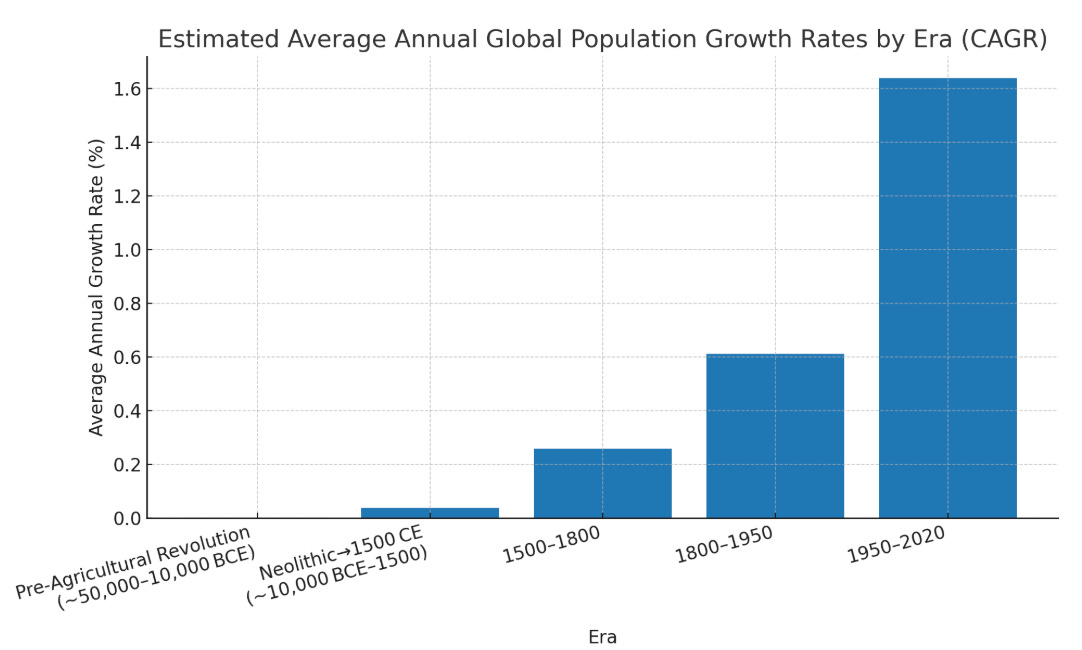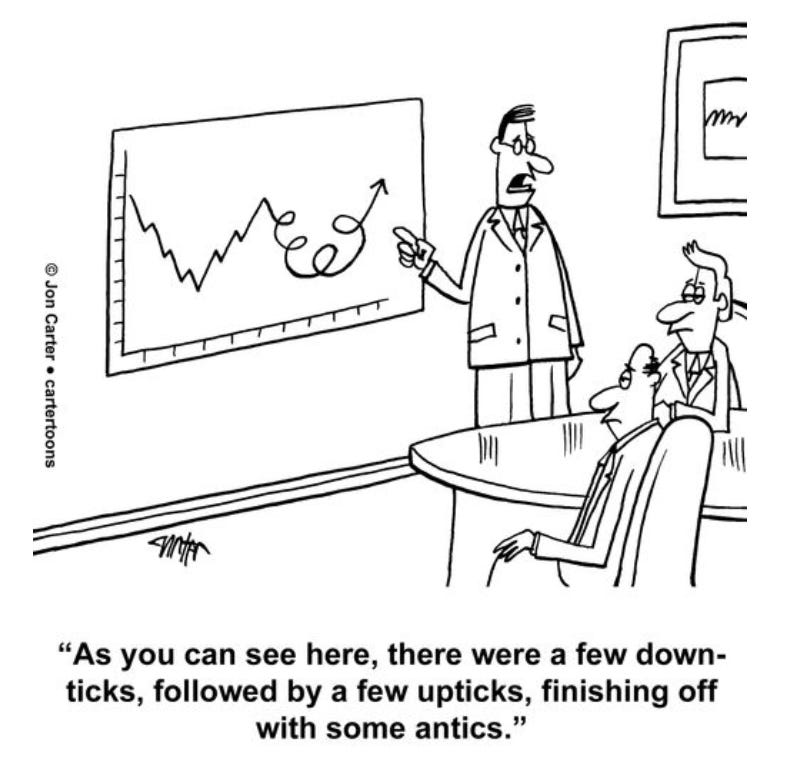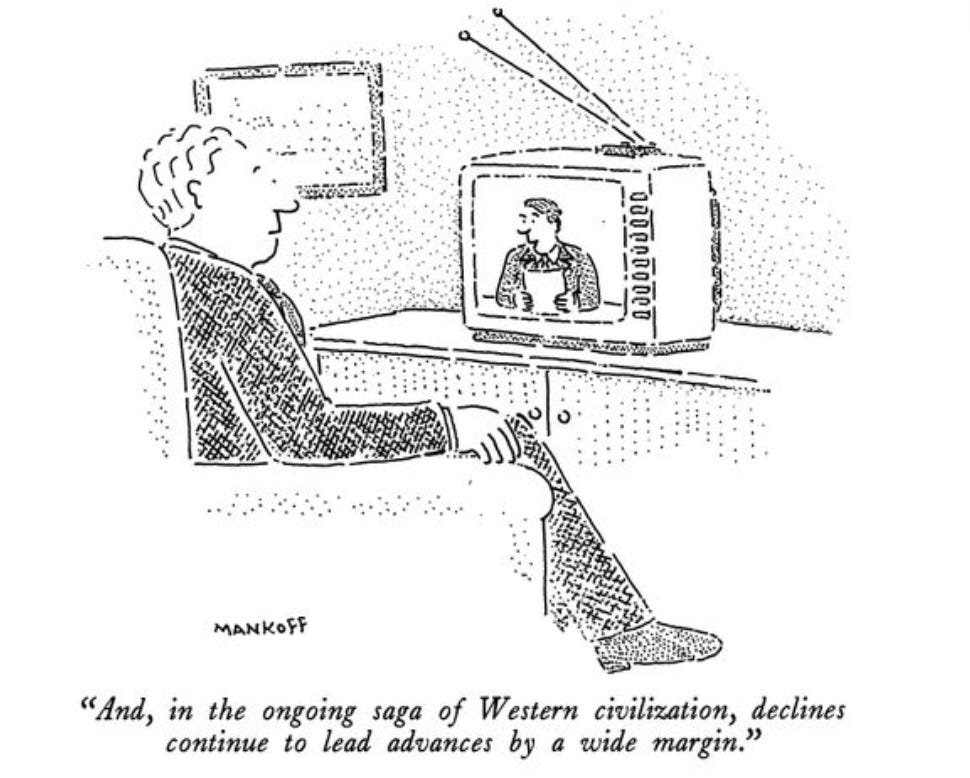In my last post, I described how people are turning to far-right leadership in backlash to several recent social revolutions which threaten their sense of how the world is supposed to work.
The end of “predictable progress”
Confidence in political institutions is plummeting because people do not see the "predictable progress" to which they have become accustomed. A Gen Z economist reports about her generation:
What does it feel like if you can’t see your way to a house, if you’re not sure what the career paths are, not sure what A.I. will do?…There’s a lot of nihilism, concern, fear and anxiety. …people… don’t really know what to do. This path that has been instilled in you from the time that you were little — go to college, graduate and buy a house — is now out of reach.1
Source: Bob Mankoff, www.CartoonStock.com
Upon what ground can Gen Z—and we—build a livable future?
Like all previous generations, we must build the future on what we can use of the past: Our accumulated resources, abilities, and experiences!
Let’s review the experience of humankind, broadly:
Phase 1: Little or no material progress
It’s important to fight our tendency to consider only very recent history. We have all of human experience to draw on!
Modern humans appeared about 200,000 years ago.2 Assuming a new generation every 20 years, we have 10,000 generations of human experience as a resource.
Fortunately, the historical disciplines—history, archeology, linguistics, and evolutionary psychology, have discovered much about these 10,000 lifespans.
What do they have to say about “predictable progress”?
For almost the entirety of the human experience, there has been no lasting material progress.3 The best indicator is the size of the human population—because until recently, societies maintained as many people as they could feed.
Source: Mark Godfrey, www.CartoonStock.com
Here is a chart summarizing global population growth rates, from pre-10,000 BCE to 2020.4
Perceptible growth begins with the Agricultural Revolution, about 600 generations (12,000 years) ago, but the average annual growth rate remains below 1/20th of a percent until 1500 CE. In short, only after 9,975 generations (out of 10,000) does a significant, clear and steady increase in human numbers emerge, with annual growth rates over 0.2%.
And only for about the last 3-4 generations, since about 1950, has the global growth rate shot up to over 1.5%!
(If you object that an annual growth rate of under 0.2% is substantial, would you be happy with an annual paycheck raise of that size?)
Caught in a Malthusian trap
Of course, some societies did grow in total population for extended periods of time. For example, the Roman Empire, or China under several Chinese dynasties. However, until very recently, this growth was not accompanied by a durable rise in the per capita (per person) standards of living of their members.5
The economist Thomas Malthus (1766–1834), first suggested the idea is that before the modern industrial era, most societies were caught in a balance between population growth and food production.
When technology or organization improved (better farming, irrigation, conquest of new land), food supply increased.
That extra food meant populations grew.
But as populations rose, land was divided more thinly, and there were more mouths to feed.
Eventually, population outpaced production. This led back to famine, disease, war, or social collapse, which pushed population down again.
This cycle is called the Malthusian trap—until very recently, it prevented sustained per-capita (per person) economic growth.
Conclusion: On a global scale, there was almost no durable human material progress except in the last 4 out of 10,000 human generations!
That is the historical baseline. Not “predictable progress”. No progress!
Source: John Carter, www.CartoonStock.com
Phase 2: Our revolutionary “modern” age
What transformed the human experience about 1800, and definitely since 1950, were three interlinked revolutions.
The Scientific Revolution, since 1600 CE, which created a set of cultural practices for reliably extending human understanding of the material world and the improvement of human lives.
The Democratic Revolution, since 1789 CE, which created a set of political practices for basing government on the consent of the governed and the rule of law.
The Industrial/Capitalist Revolution, since about 1800 CE, which created a set of economic practices for replacing human labor by machines and organizing production on the basis of market transactions and an appropriate level of government regulation.
Source: Baloo, www.CartoonStock.com
Together, these revolutions liberated the productive capacities of the human race, and then accelerated their growth over time.
Some modern societies began to integrate these revolutions into everyday life since the revolutions’ origins (the US, UK, France). Eleven generations later, these societies’ modern citizens so thoroughly take them for granted that most people assume that constant social material improvement—i.e., “progress”, is normal and automatic.
Other societies embraced the modern revolutions as recently as around 1950-80 (China, India, other Asian and African countries, and really, much of Latin America). There, three generations into this process, many people who lived the pre-modern reality are still alive. They, and many in the generation after them, much better understand that “progress" is not automatic or assured.
Pre-modern harsh realities
In 99.98% of human historical experience, material conditions have not improved in a straight line upward across time, but rather, they’ve constantly cycled up, then down, then up, and so forth.
One may have enjoyed a few good decades.
But these were inevitably followed by the arrival of one or more of the Four Horsemen of the Apocalypse: Famine, Disease, War and Social Collapse.
Source: Jonesy, www.CartoonStock.com
Modernity’s “secret formulas”
No society could break that cycle—until around 1800, when, as in the “Rumpelstilskin” fable, humans stumbled onto some unlikely “magic formulas” for turning straw into gold:
Intellectually, how to transform human insistence on always claiming to be right into the “gold” of a collective process for producing reliably useful conclusions about how the natural world operates, and how it can be turned to human benefit. (The scientific method)
Politically, how to transform humans’ lust for power and status into the “gold” of a system for channeling citizens’ democratic inputs through “checks and balances” among governmental powers so as to protect citizens’ liberties and minority rights. (Liberal democratic institutions)
Economically, how to transform humans’ selfishness and material ambition into the “gold” of a system for allocating resources among economic actors so as to encourage their best efforts and minimize total waste. (Private property, trade, markets, and appropriate government regulations)
Each of these systems is ingenious and deep. None of them run themselves. All require participating humans to understand what is required, and then, to carry it out. This includes constantly updating them, in response to new developments.
Source: Norman Jung, www.CartoonStock.com
We forgot the magic formulas
In the U.S., we forgot that maintaining the magic took work.
We forgot that maintaining the magic took moral decency: That even systems designed to function on a fuel of human frailties need operators who don’t habitually lie, cheat and attack others—or who once in power, make the government into a tool to punish their enemies and enrich themselves and their toadies.
We forgot that maintaining the magic took courage: That a governing system based on checks and balances requires legislators, officials and civic leaders who don’t fearfully relinquish their power to a vengeful would-be dictator.
We forgot that maintaining the magic took civic and historical knowledge: That for citizens to give informed democratic input, or to defend the systems on which all their security and happiness depend, they must be taught to learn and value the basics of their governing system and human history.
The penalty for our carelessness is severe and escalating. Chief of all, of course, what’s quickly slipping from our grasp is the precious distinction of escaping the traps that hobbled all previous societies—and which allowed us to achieve durable, predictable progress.
The Four Horsemen now converge upon us.
Which will arrive first? Famine? Disease? War? Social Collapse?
Source: Bob Mankoff, www.CartoonStock.com
What is to be done
Upon what ground can Gen Z—and all of us—build a livable future?
Reacquaint ourselves with the “magic formulas” that made recent human generations uniquely successful in history. Learn, and discuss!
Engage with our fellow citizens to revise these formulas to respond to recent existential threats. Among these are climate change, the rise of AI, escalating economic inequality, the resurgence of fascism, and the empowering of the Axis of Evil6 internationally. Learn, and discuss!
Re-dedicate ourselves to the work of restoring, protecting and building upon the historic accomplishments of the scientific, democratic and industrial/capitalist revolutions. Stand up, and organize!
“Those who do not study the past are condemned to repeat it.” George Santayana
Each of my posts is part of an extended strategy for how to surmount the polycrisis. This evolving strategic analysis is organised by themes, in a separate post, “Posts, organised thematically”, which I invite you to consult.
“How the Attention Economy Is Devouring Gen Z — and the Rest of Us” Kyla Scanlon, interviewed by Ezra Klein. New York Times. July 8, 2025. Scanlon is a Gen Z economics writer and educator.
Principal papers supporting the use of this date for the appearance of Homo sapiens sapiens are:
McDougall, I., Brown, F. & Fleagle, J. Stratigraphic placement and age of modern humans from Kibish, Ethiopia. Nature 433, 733–736 (2005).
White, T.D., Asfaw, B., DeGusta, D., Gilbert, H., Richards, G.D., Suwa, G., & Howell, F.C. Pleistocene Homo sapiens from Middle Awash, Ethiopia. Nature, 423, 742–747. (2003).
I take “material progress” to mean increasing access to food, housing, health care, transportation options, and eventually, other consumer goods. The American Dream!
Principal sources for the population growth estimates underlying the rates summarized in this chart are:
Atlas of World Population History By Colin McEvedy & Richard Jones. Facts on File. 1978.
Contours of the World Economy, 1–2030 AD By Angus Maddison. Oxford University Press. 2007.
World Population Prospects United Nations, Population Division.
“Breaking out of the Malthusian trap: How pandemics allow us to understand why our ancestors were stuck in poverty” By Max Roser, The World in Data. November 26, 2020.
In an earlier post, “Moral clarity”, I argue that today we confront a new international “Axis of Evil", which has amply earned its characterization as “evil”, and which includes Trump, Putin, Bibi, Orban, etc.









